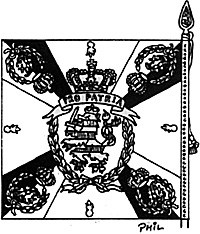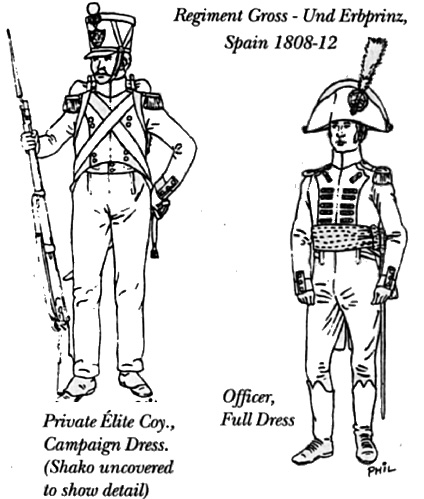
from Peter Hofschroer
Organisation
Hessen-Darmstadt joined the Confederation of the Rhine on July 12th 1807, its ruler becoming a Grand Duke and gaining additional territory as a result of this. The Grand Duchy of Hesse was required to provide 4,000 troops to its protector, the French Emperor.
In 1808 a contingent of two battalions of infantry and an artillery section of four companies was sent to Spain under the command of Colonel von Ledebur. This force was known as BRIGADE GROSS UND ERBPRINZ (Brigade of the Great and Hereditary Prince). The contingent fought until the siege of Bajadoz in 1812 where it was taken prisoner. It was transported to Britain and held there until 1814.
Tactics
The infantry used the regulations of 2nd March 1805 until 12th February 1810 when these were replaced by the French regulations
Uniforms
Headwear was of a French pattern, supplies of which indeed came from France. Officers wore the bicorne. The force in Spain was organised after the French model, each battalion comprising four companies of Fusiliers, one of Grenadiers and one of Voltigeurs. French-style distinctions were introduced - the Grenadiers sported red plumes, shako cords and red fringed epaulettes; the Voltigeurs green, the epaulettes with yellow crescents and the Fusiliers had blue shoulder straps faced yellow. These had a weather-proof cover when on campaign.
The unit wore yellow collars, lapels and cuffs with pewter buttons. The blue coat was lined red on the tails. The lapels were worn only on parade during this campaign. On parade a white waistcoat was worn but this could hardly be seen under the coat. Officers had silver lace and epaulettes, but on campaign an unembroidered frock coat was worn. Legwear consisted of blue overalls and black gaiters, the latter fastened with black buttons. These were later replaced by blue overalls with a yellow stripe worn over the gaiters. In Spain these were in turn gradually replacedby long brown trousers with a yellow stripe. Officers wore blue trousers with knee boots. NCO distinctions followed the French pattern.
Equipment
A calf-skin pack was worn over both shoulders. Crosbelts were white. A lion badge adorned thye black cartridge box. The old Hessian sabre was worn as a side arm but this was later replaced by the French pattern.
Armament consisted of the Prussian Northardt muskets captured in 1806, later the Austrian 1784 pattern and finally the French Charleville. Officers carried Prussian pattern epees with a silver and red tassel and sash.
The gunners wore a largely similar uniform. Facings were were black piped red. Tails were lined black and piped red. Drivers wore a similar uniform without the red piping and with white trousers and black boots. They had a felt hat trimmed with a red pompon.
from John Henderson
Regiment Gross - und Erbprinz was specially formed for service in Spain from the 1st and 2nd Musketier - Bataillons of Erbprinz Ludwig's Brigade and the 2nd Leib - Fusilier bataillon. These were reformed on 23rd August 1808 at GrossGerau into a regiment on the French pattern (see above).
I think it impossible to say for certain what the unit wore during its long service in Spain. It fought at the battles of Medellin, Talavera and Ocana, and in 32 other named actions. During this long period of continuous service the wear and tear on uniforms must have been considerable. My illustration shows my interpretation of what some members of the regiment probably wore when they first went to Spain.
Blue coat, yellow collar,cuffs and lapels; red turnbacks and blue shoulder straps. White buttonhole lace and white metal buttons. Black hat with red and white cockade and tighteners, white pompon. Blue waistcoat, white breeches. Brass hilted sabre in black scabbard.
Only the former musketeers would havre worn the above. The Fusiliers wore a green Fusilier-style dress. They would have been mixed indiscriminately in all 12 of the new companies. After these had worn out the regiment would have had to mend and make do. It is known that items of adapted French infantry uniform were commonly worn from 1809 onwards. Brown trousers with yellow stripes are recorded, also blue breeches with Chasseur-style gaiters, blue shoulder-straps piped yellow and olive green and brown shako covers.
from Philip Gaffney
Another translation of the title could be GREAT AND PRINCELY HEIR. Statements by both Governor Phillipon and a number of senior officers praised the regiment, under Oberst Kohler for its defence of the castle at Badajoz. The regiment was re-raised on May 7th 1814.
It is unclear whether or not the unit wore French or Hessian company pompons. Perhaps they wore there own, replacing them with French ones because of the state of supplies. Hessian colours were Ist coy., White; 2nd., Black; 3rd., Blue; 4th., red; 5th., White over blue; 6th., Black over white; 7th., Blue over white; 8th., Red over white. One reference mentions white turnbacks emblems for the elites - grenades and hunting horns. Forgae caps were dark blue with yellow piping and tassel.
Fusiliers may have carried sabres as well as the elites. If so, sabre-straps were white (red or green for elites) with company coloured tassel.
Distinctions for drummers and hornists are barely mentioned, and seem to have been yellow swallow's nests with a white band inset along the bottom edge. The only reference to instruments is that drums were brass with red and white hoops, and horns of traditional German design.
It is known that in 1809 coat-tails were cut off to patch up the uniform until new clothing could be issued.
Colours
 Each battalion had two flags but only one per battalion were taken to Spain. They were captured by Private George Hatton of the 4th foot at Badajoz (at one time they were displayed in the flag hall at Greenwich - does anyone know what happened to them?)
Each battalion had two flags but only one per battalion were taken to Spain. They were captured by Private George Hatton of the 4th foot at Badajoz (at one time they were displayed in the flag hall at Greenwich - does anyone know what happened to them?)
The flags were 130cm square and fixed to 315cm long black hafts with 40-50 gold nails. The cypher appeared on the pierced gold spear-head. Cords were silver worked through with red.
All crowns were gold with red lining; all wreaths green with red berries and pink ribbons. In the Centre was the red and white striped Hessian lion on a blue field (silver sword, gold hilt) Above was a red scroll with gold inscription. The corner cyphers (LLX - Landgraf Ludwig X) were gold. The grenades were silver and red.
The field of the 1st battalion (a Retirirfahne) had a black cross and yellow corners; that the the 2nd (an Advancirfahne) had a white cross, with halved black and yellow comers.
Sources
Bredow-Wedel. HISTORISCHE RANC- UND STAMMLISTE DES DEUTSCHEN HEERES. Berlin, 1905
Hagger, D. Hessian Regiments and their colours in ARMY & NAVY MODEL WORLD, June 1985
Keim, A. GESSCHICHTE DES 4. GROSSHERZOGLISH HESECHEN INTANTERIE - REGIMENTS PRINZ CARL
Nr 118. Berlin, 1879
Pivka,O von. NAPOLEON'S GERMAN ALLIES (5) HESSEN-DARMSTADT & HESSEN-KASSEL: Osprey
Sauzeyj LES ALLEMANDES SOUS LES AIGLES FRANCAISES. Tome VI. Paris, 1912
Windrow, M MILITARY DRESS OF THE PENINSULAR WAR, Windrow & Greene, 1991
Wise, T FLAGS OF THE NAPOLEONIC WARS (3), Osprey.
Thanks to the above for their replies to this query and apologies for hacking the pieces about to avoid duplication. A colour illustration appears in the last given source, along with a mention that two companies were denied quarter by the 88th foot, who had suffered heavy losses whilst assaulting the breach. - Eds.

More Replies
Back to Napoleonic Notes and Queries #3 Table of Contents
Back to Age of Napoleon List of Issues
Back to MagWeb Master List of Magazines
© Copyright 1991 by Partizan Press.
This article appears in MagWeb (Magazine Web) on the Internet World Wide Web.
Other military history articles and gaming articles are available at http://www.magweb.com